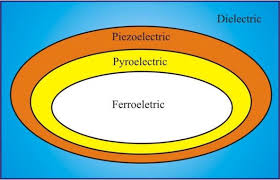Ferroelectricity:

Researchers at Oak Ridge National Laboratory (ORNL) have developed a breakthrough technique to visualise the dynamics of domain walls with unprecedented detail.
- Ferroelectricity is a property of certain non-conducting crystals or dielectrics that exhibit spontaneous electric polarisation, where the centres of positive and negative charges separate, making one side of the crystal positive and the other negative.
- This electric polarisation can be reversed by applying an appropriate external electric field.
- The term ferroelectric is derived from ferromagnetism, where magnetic domains align spontaneously; similarly, in ferroelectrics, electric dipoles align spontaneously in domains.
- Examples of ferroelectric materials include barium titanate (BaTiO₃) and Rochelle salt.
- Ferroelectric domains are clusters where dipoles are aligned. These domains can be reoriented by strong electric fields.
- The delay in response when domains reorient is termed ferroelectric hysteresis, analogous to ferromagnetic hysteresis.
- Ferroelectricity vanishes above a critical temperature called the Curie Temperature, where thermal agitation disrupts dipole alignment.
- Domain walls are the boundaries between differently polarised regions in a ferroelectric material.
- These walls often exhibit electrical or magnetic properties different from the surrounding domains.
- Some domain walls may become electrically conductive even when the bulk of the material is non-conductive, or magnetically active even if the domain itself is nonmagnetic.
- These unique properties make domain walls potential candidates for nanoelectronic components for memory, sensing, and signal processing in low-power devices.




